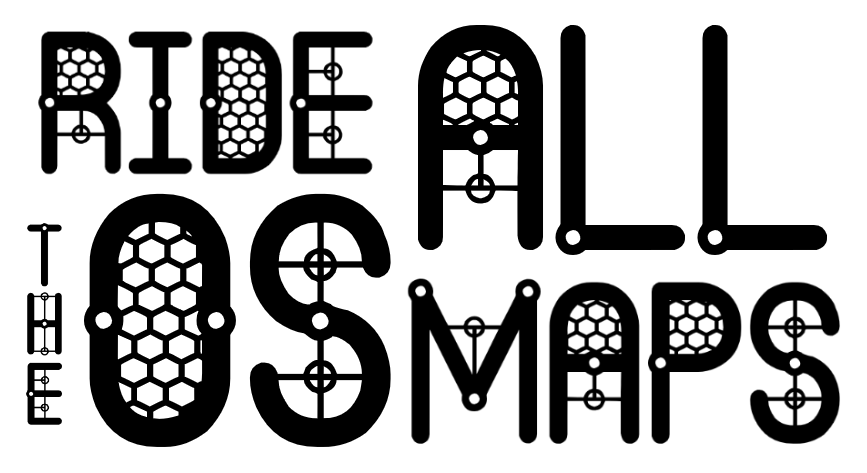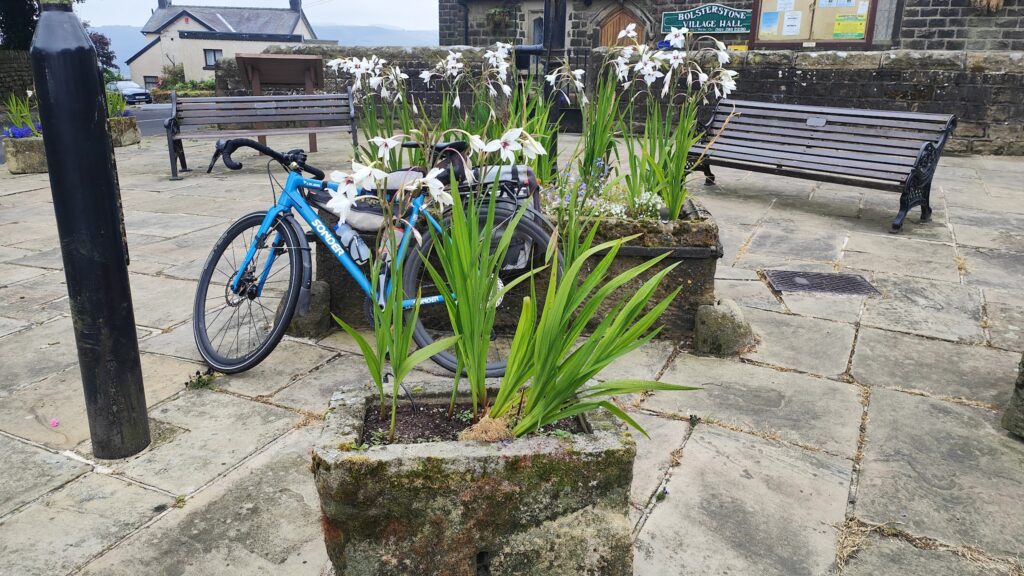
It was time, the spinner said, for me to cycle north in a straight line until I reached the sea in Northumberland. From an OS maps point of view, this was an easier route to plot, because – just like my route south – it was already printed on the map by the OS as the blue line of latitude numbered 23. There was no guessing involved on my part at all. But that didn’t make it any easier to construct a straight line route where roads didn’t go. Once again, the first section from home took me out along tortuous, twisting lanes over Strines Moor and down into pretty Lower Bradfield and it’s picturesque cricket pitch.
A women’s 8-side game was underway and they all seemed to be having a marvellous time. I watched for a couple of overs and became quite absorbed. The teams were wearing pyjama-like kits, which mimicked the professional cricket leagues, but there the similarity ended. The teams batted in pairs, each pair for a few overs. If one of them got out, they simply swapped ends. All the bowling was from one end and it varied enormously in quality. I think everyone on the fielding team got to have a go at bowling. Some of it was very slow and some very wayward, making batting a tricky business. The umpires were being quite lenient with wides!
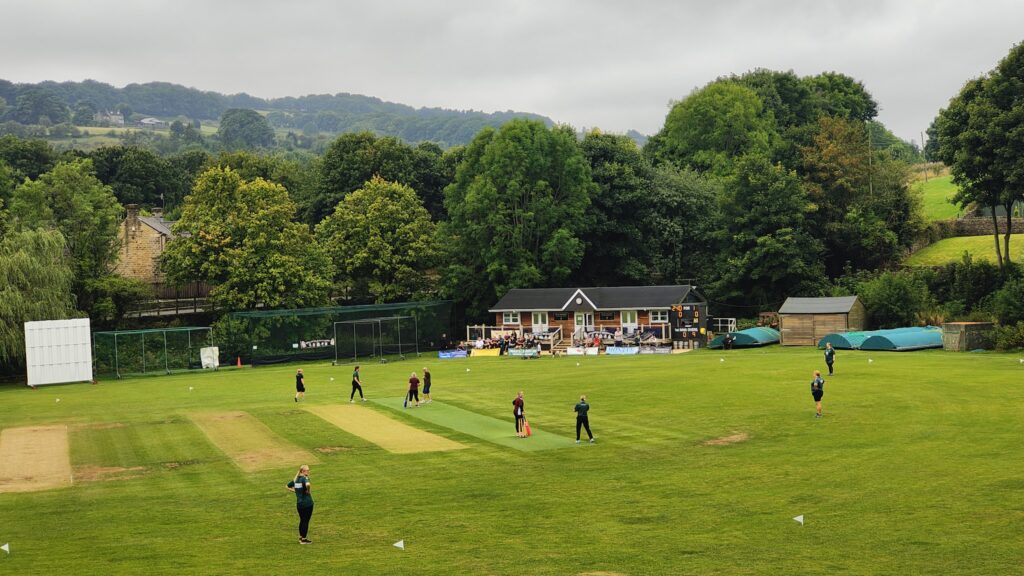
Nothwithstanding all of these limitations, it was a highly inclusive occasion and anything anyone did was warmly appreciated by their team mates. If sport is about having fun then everyone here was a winner. I chatted to the father of one of the players, a fourteen year old, who was from Doncaster. He was blown away by the beauty of the setting. He was a former player, as am I, and it turned out we knew people in common at Doncaster Cricket Club. The age range in his daughter’s team today was 14 to 72, and there was a similar range in size, shape and speed across the ground. Most of the runs I saw scored were in balls hit for four. The ball itself was soft and orange, and no one seemed to be wearing any batting gloves. I’d never quite seen cricket like this before. I hope it catches on even more widely. I can tell you from experience that in “proper” cricket you can spend most of a day doing very little if you fail with the bat, or are not required because your team mates do well enough without your efforts. I was mainly a bowler; but that, too, can lead to long periods of inactivity down at long leg, depending on the whim of your captain. It was enough to put me off making the commitment, but in this format these ladies were all in it together.
Somewhat reluctantly, I tore myself away from the action and the conversation and headed back off uphill. There is a small road that climbs up away from Bradfield along the banks of Agden reservoir, avoiding the very stiffest of the climbs around here and helping me steer a careful course in between my previous rides NNE and NNW. I had these lanes to myself today in the grey cloudy conditions; and my straight line north was maintained by navigating some of the tiniest surfaced lanes you will find anywhere. The downhills were steep and went around sharp bends that required some serious braking, but I got down safely to the banks of the Broomhead reservoir and then ascended again on the not-for-softies climb up to Bolsterstone village. Here I briefly touched my route NNE, because it was impossible not to; but then quickly ricocheted away and continued my roller coaster ride as far as the small town of Penistone, where I decided I should stop for refreshment. Beyond here, today was something of a mystery and I didn’t want to leave things too much to chance. Penistone is a decent little place, with a train station and a long and impressive viaduct on the Sheffield to Huddersfield line. It also possesses an old fashioned cinema, The Paramount, which has been in continuous operation for 110 years. I found a fancy burger place on the high street and loaded up on calories for the hills ahead. I knew today would test my climbing endurance, so fuel mattered, and I had left home with not much more than two pieces of toast inside me.

From here, my next landmark – literally – was Emley Moor TV Transmitter. On a less cloudy, misty day, I might have seen this slender tower shining like a beacon ahead of me, reaching for the sky. Today, the UK’s tallest free standing structure was a dark silhouette against a grey sky, with its head lost in the clouds. It was all rather ethereal, but no less impressive close up than in better weather. If something is high enough to disappear from view in the clouds, it is tall. Emley Moor, in fact, tops out at 330 m (or 1,080 feet), which is more than twice the height of the Blackpool Tower and slightly taller than the Eiffel Tower. It’s lofty location on the top of the moors above Huddersfield gives it a sense of even more extreme height. For something about which so little fuss is made, I think it is a marvel to behold. When you get up close to it, all you can really do is stare upwards, because there is no way in or up. Television and radio are broadcast from here to five million people, from Lincoln to Darlington to Skipton.
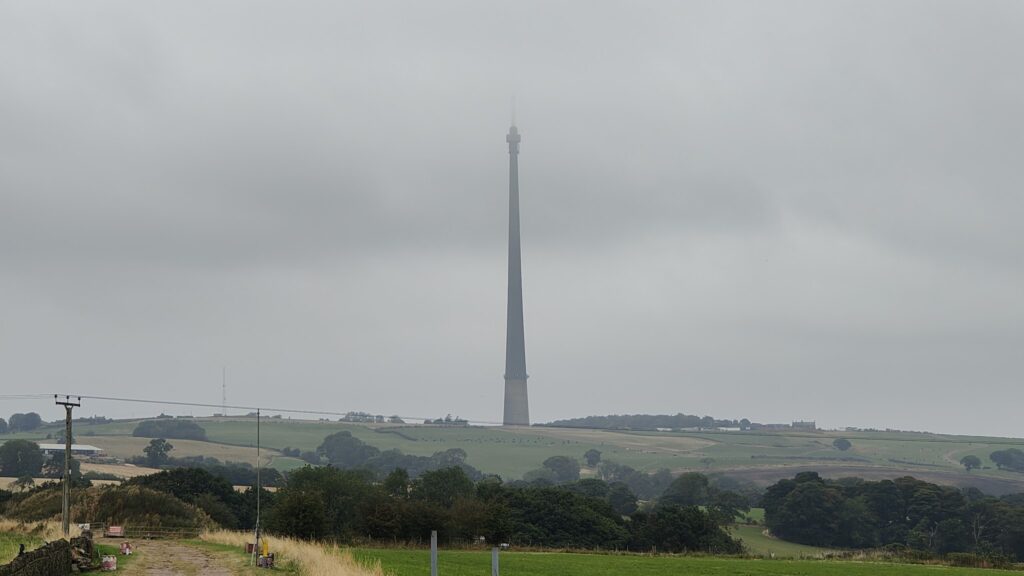
It was now a slightly fiddly downward route north, because all the roads seemed to want to go somewhere else. When I reached the next big town, just off the top edge of OS map 110 (whose bottom section I call home), I realised why. That town was Dewsbury, followed in short order by Batley. These are names I know well enough, perhaps best as lower division rugby league teams, but I had never set foot there. I always try to arrive somewhere new with an open mind, and I was hoping Dewsbury might unexpectedly delight me. It didn’t. Quite the reverse in fact. I was now in the land of dark, satanic mills, once at the heart of the textile industry. Like Bolton and Halifax, I found that Dewsbury has a fine, imposing town hall, with a splendid clock tower. This is the highlight of an otherwise very depressing townscape. I saw nothing much to like and much to make me resolve to stay away. For a start, the whole place needed a good tidy up. But the decay and depression was more than just on the surface. It felt like a place that had lost its soul, and perhaps worse, any sense of pride. There were some potentially good buildings, and some signs of efforts to reverse the decline, but I found myself wanting to move on as soon as I could and hope this wasn’t the shape of things to come for the rest of the day. I would, after all, be treading a narrow line between the major industrial cities of Leeds and Bradford, and passing through some of the smaller places, like these, that I couldn’t avoid. These are mostly places I have only ever really seen at arms length and at speed from a car window on the M1 or the M62. If at all. Were they all like this up close?

The answer is a definitive “no”. There were some really nice places just a few miles away and Dewsbury was certainly the low point. My mood had already been partly lifted in Batley when I quite unexpectedly realised that I was riding right past the showroom selling Shackleton’s High Seat chairs. I wouldn’t have given it a second thought except for their television adverts that we grew up to in the Yorkshire Television region, which were vintage TV culture of the age. It ranks alongside the likes of “Do the Shake and Vac” and “For Mash Get Smash”. If you grew up elsewhere, you missed out. Anyway, I couldn’t quite believe my eyes that it was still here, and I was genuinely sad that the showroom was closed this Sunday afternoon.
My route today was complicated; but I knew I was on the right track when I arrived in Pudsey. It is a name we all know from Children in Need, but I had never been to Pudsey. It is a small town that sits squarely between Leeds and Bradford, and it’s a nice little place. Just down the road is another former industrial mill town called Farsley, known to me only as a non-league football team. But Farsley is much more than that. In fact, if you look at what it has and where it came from, there is much in common with Dewsbury and Batley. There are still old mills and even a large, ugly block of flats in the middle of town. But Farsley is everything that Dewsbury wasn’t. It is clean, attractive, full of interesting bars and shops, and altogether the sort of post-industrial community you might happily consider moving to if you worked in central Leeds, for example. I bet the house prices here reflect that, too. So perhaps, one day, Dewsbury can take the same route forwards and become a desirable place to live without the metal shutters and run down town centre. The ingredients are not so different. Let’s hope so.

After Farsley, I landed accidentally on the banks of the Leeds and Liverpool canal in the Aire valley, and followed a cycle route for a short time. It was very pleasant, and led me up into Horsforth and then beyond into the hilly countryside on the northern edge of Leeds. I plotted an indirect route that took me through Yeadon and then Guiseley (home of the original Harry Ramsden’s Fish And Chips), two more small Yorkshire towns, with nice independent shops and proper little town centres. They both felt and looked welcoming and relatively prosperous, albeit rather close to Leeds Bradford Airport and the noise that brings with it.
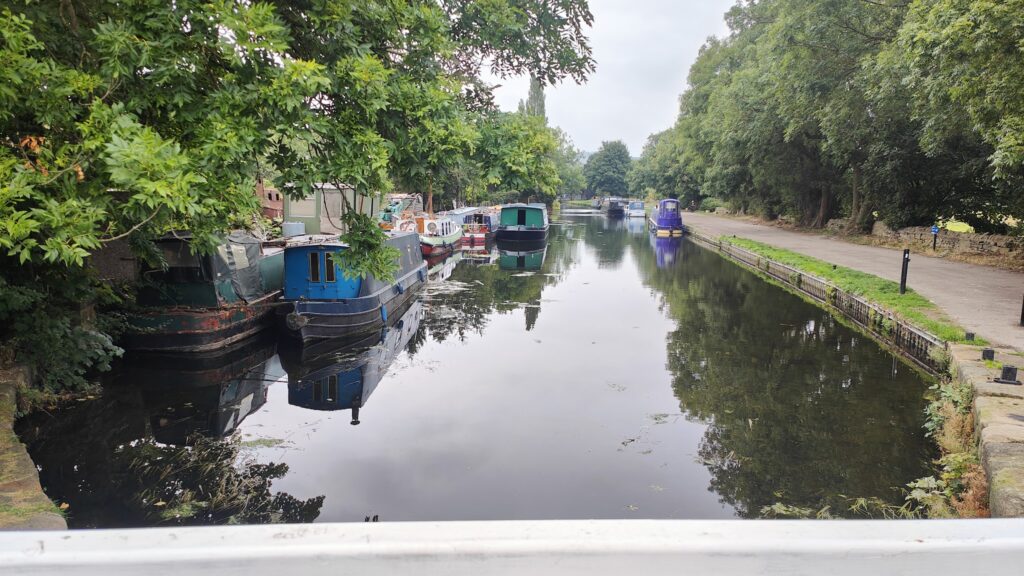
And from there it was all downhill, literally, to Otley, in the Wharfe valley. It is a pleasant little town, too, with a good range of tempting pubs. I had booked a small apartment tonight for a heavily discounted price and – aside from some gymnastics to get my bike inside – I couldn’t quite believe my luck. I gleefully watched Liverpool thrash Manchester United on the telly while I ate my take away pizza. It hadn’t been the sunniest of days; but it had surely been a good one, without a drop of the threatened rain falling on me. I had seen much more of Yorkshire, the county of my birth, for the first time than I could have imagined for any other reason; and in a day of 66.6 miles of hilly cycling had learned plenty about the world not very far, as the crow flies, from my home. And that has to be a good thing.

